The human brain is a facile machine that can pump out an ocean of ideas. Some are gold, some are dross and fate may have it that some will fade into obscurity. A designer’s legacy is that portion of his or her creations that outlives them. Those who have achieved fame will see even the most obscure part of their work searched out and studied. The best of what we are remembered for is not merely popular. It is true, honest and highly valued.
John Magner was not a prolific creator of so-called “important” yacht designs. He was not a Herreschoff or an Olin Stephens. He worked on a simpler level mainly building boats that came from other men’s drawing boards. He did a fine job of it. His small boats, El Toros, San Francisco Pelicans, and Atkin schooners were the unpretentious craft that introduced children to the ways of wind and water. They brought families together for recreation and the sort of fellowship that creates strong bonds.
I imagine him culling the work of many years for the elements that pleased him most. Out of that material, his own nautical brainchild was fashioned. He called it the Dungeness Crabber. It has the look of similar traditional boats in the mold of British coastal working boats. It gets its name from the bay that lies in the shelter of the Strait of Juan de Fuca’s Dungeness Spit.
I first encountered the Crabber back in 1984 while reading an issue of Small Boat Journal magazine, a publication made for boat dreamers with small incomes. An advertisement caught my eye for plans to build a 21 foot 8 inches long pocket cruiser with a plywood hull. She had a salty looking gaff rig and a roomy cockpit that spanned the full width of the boat aft of the cabin. The traditional look with a sweeping sheer that blended perfectly with the bold bowsprit grabbed my interest.
I immediately sent off five dollars to Magner & Sons Boatworks for a study plan package. The study of boat plans has been a harmless obsession of mine since I first stumbled onto Howard I. Chappelle’s The Search For Speed under Sail in the high school library. The lines that bring the three-dimensional shape of a boat’s hull alive on a flat page and the detailed exposition of the timber construction of an ocean-going vessel seemed like high art. John Magner’s neatly rendered drawing of his Crabber gave me some pleasant hours of daydreaming. It seemed like the sort of boat one could actually bring to life in a two car garage 100 miles from salt water. At the time my life was not conducive to the project and sailing had been largely set aside in the pursuit of a pilot’s license. Yes, I am a scattered chaser after dreams.
Several years later the altering fortunes of our nation’s economy made it plain that I could not own an airplane and a sailboat at the same time. A serious examination of my priorities caused me to choose a sailboat. I liked the idea of building something bigger than my San Francisco Pelican and the Crabber seemed like just the ticket. I had the funds to make a start but the time factor poked at the center of my impatient spirit. If I was to give up flying I wanted a small cruising boat as soon as possible. The Annapolis boat show settled the issue with a sweet deal on a Seaward23, the Dragonsong that I have written of frequently in this blog.
If we old sexist sailors regard boats as female in name, form, and temperament then I guess the Dungeness Crabber was the one that got away. She faded in memory and did not emerge again until I moved to The Olympic Peninsula of Washington where I kept wondering why the town of Carlsborg was jingling a little bell in my head. I have already related the story of the little Atkin Schooner sitting in the yard of John’s son. When I sat down with Kevin and Brian Magner to gather information on Florence Oakland I had an opportunity to see the full plan set of the Crabber. There in bold detail was the pocket yacht I remembered from a long time ago. The four pages of hand-drawn prints from a time before Autocad made engineers into mouse pushers showed carefully drafted construction details and a complete materials list. You can always tell when a draftsman has spent a lot of time in the shop.
A good set of plans show a sailor all the tools that will be at his disposal while underway. The gaff cutter rig has enough lines to keep a couple well occupied without making single-handed sailing out of the question. Everything from the throat and peak halyards to the lazyjacks was on the right scale and workmanlike in a seaworthy fashion. Her multichine hull features chines backed up with stringers. It was strong construction although my mind immediately considered the idea of stitch and glue seams.
I don’t know that you could say the boat would be a cheap build. Marine plywood is expensive these days and a gaff rig wants a fair number of blocks, thimbles and a chandlery full of bronze bits and bobs. With a sailor’s attention to detail she’d turn out to be a proper little ship. The hull construction would allow for trailering, thus avoiding moorage fees. However, the setup time at the launching ramp might try one’s patience. Hauling her home for the winter, bottom painting and all the maintenance that boats crave would be a snap.
The cabin looks snug with berths for two. It cries out for a wee woodburning stove. Â I can see myself at anchor with a kettle on the boil, tea bags at the ready. There’s some lemon juice in the cooler and a pint of rum discreetly situated among the small library of books on a shelf above the settee. It’s the perfect setting for hammering out the kind of nautical nonsense I dispense on the internet as well as in mixed company.
When I first talked to them John’s sons did not know of any surviving examples of the design. They remembered one that was built and went to live in Southern California. I’d had no luck with Internet searches. A message posted on the WoodenBoat Forum rendered a few nice comments but it wasn’t until recently that I got a message telling about a Dungeness crabber that was built and launched in Australia. The story of her adventures in launching which include a twisted tabernacle and the help of friends from the Wooden Boat Association of Australia are recorded in the article The Launch and Mast Raising of Rufus, The Dungeness Bay Crabber.
Rufus was built by Geoff and Jill Carroll beginning in 2004. The boat was lofted on his dining room floor on sheets of MDF. The next four years was spent constructing blocks, bulkheads, transom, stem, keel and skeg and a centerboard case in Geoff’s spare time and school holidays while teaching full time. A strongback was built in the backyard for further construction. The hull was built upside down and turned over in 2010. After constructing the cabin and laminated deck beams fitting out was completed in 2013. The construction of masts and spars followed.
Considerable effort went into launching Rufus. The boat had to be dragged across the Carroll’s yard after which the boat movers delivered her to the marina. While raising the mast it twisted, damaging the tabernacle. The transport company made good the damage by manufacturing a new steel tabernacle to replace the wooden one. This was followed by a formal mast raising and Rufus was christened with a bottle of Magners cider in honor of John Magner her designer.
Geoff kept Kevin Magner informed of the launching and the initial sailing trials. Rufus makes a good impression everywhere she goes. Geoff says, “she gains a great deal of comment by those walking past the Marina in St Kilda, Melbourne. One passerby commented, ‘Now that’s a boat with soul’ It made my heart glad.” Geoff and his wife Jill enjoyed the assistance throughout the project of friends and fellow members of the Wooden Boat Association of Australia.
Geoff made a short video while sailing Rufus from St Kilda in the NE corner of Port Phillip Bay to Werribee South. That’s about 30 kilometers from Melbourne. The trip took about four hours due to fickle winds at the beginning of the journey. The next day’s return trip only took about three hours. The video shows Rufus running with the wind over the starboard quarter with a reefed mainsail. She looks to be moving well without causing the crew any undue stress.
The trip was the third time that Geoff had taken the boat on a trip out on the bay. He reports that two people spent a comfortable night below decks in her quite adequate accommodations.
Geoff stated that he did not know of any other Dungeness Crabbers in Australia. A single known survivor of a fine builder’s legacy is surely not enough. But Rufus is a fine example of a small boat sailor’s dream.
There is a connection one experiences with a handy vessel. It is a necessary conduit to the many aspects of the marine environment. When we take the con we do not merely drive the boat. We sail the wind and waves while contending with the tide. The senses are engaged by every facet of our surroundings. Tossed about by great forces we settle into their grasp and find our way out and back again. Every casting off of the mooring is a move from the static to the dynamic. Each connection occurs in a moment preserved in precious memory.
Later we may recall the bite of the rudder transmitted by the feel of the tiller. We hear again the snap of canvas as the mainsail fills on the opposite tack. The wind plays the rigging like a harp. It sings the tale of days running downwind racing with fairy terns or taking a trick at the wheel of a schooner reaching into a crowded Maine harbor. You steady the helm, ready to sing out to the crew anticipating the command to come about. There is delight in the slow dance she does coming across the wind. Contentment comes when the vessel surges ahead on a new tack pulling it’s weight along a new course.
A good boat gathers together each moment between “anchor’s aweigh” and “let ‘er go.” What a designer and builder create is a repository of experience; the very thing that legacies are made of.

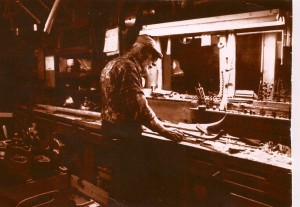

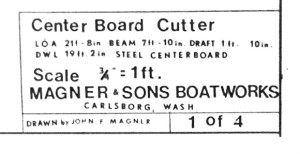
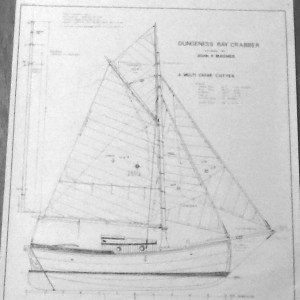
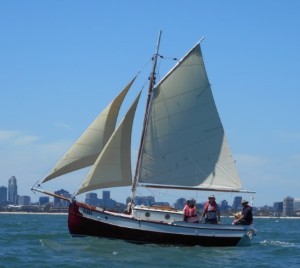
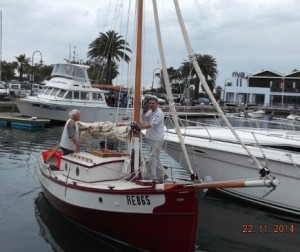


Thank you so much for this wonderful article about my Dads work. He was such a special man, a dear soul. He was self taught but just had a natural eye for design and understood the engineering of structure.
I am the oldest of his 9 children and was so lucky to have him for my father and i miss him everyday. Reading this is pure joy to me.
Erin